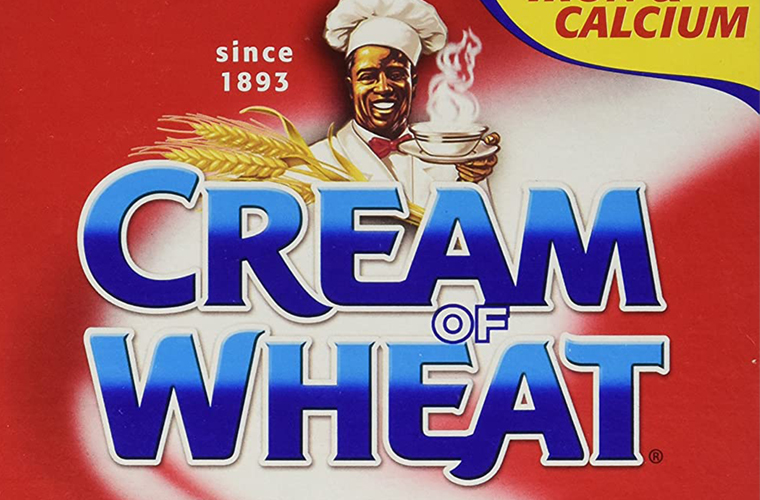“Racist” Cream of Wheat Chef Image of Frank L. White, ca. 1921
In 1893, a group of innovative millers in Grand Forks, North Dakota, revolutionized the breakfast table by transforming wheat middlings—a byproduct of wheat milling previously considered waste—into a marketable breakfast cereal they named Cream of Wheat. This “breakfast porridge” was a novel concept at the time, born during a period of economic hardship in the United States known as the Panic of 1893. Despite the financial turmoil, the product’s affordability and clever packaging made it an instant hit with consumers.
The mastermind behind Cream of Wheat’s branding was Miller Emery Mapes, a co-founder of the company. Short on capital, Mapes took a hands-on approach, personally designing the packaging for the cereal. He chose an image of a cheerful African-American chef, whom he named “Rastus,” drawing inspiration from the stereotypical “happy slave” characters in Joel Chandler Harris’s Uncle Remus stories. This caricature, like other contemporary brand mascots such as Aunt Jemima and Uncle Ben, reinforced harmful racial stereotypes of Black individuals as subservient and content in their oppression. While the image was deeply offensive, it resonated with white consumers of the era, contributing significantly to the product’s commercial success.
Relocation to Minneapolis and Industrial Growth
In 1897, just four years after its founding, the Cream of Wheat company relocated from North Dakota to Minneapolis, Minnesota, a strategic move to secure better shipping rates and a reliable supply of wheat middlings. Minneapolis, often referred to as “Mill City,” was rapidly becoming a hub for milling innovation. By the 1920s, however, Buffalo, New York, would surpass Minneapolis as the nation’s milling capital, prompting companies like Cream of Wheat to rely heavily on branding and advertising to maintain their market edge.
Cream of Wheat pioneered a marketing strategy that transformed an inexpensive commodity into a household staple. The company employed cutting-edge four-color printing technology to create visually appealing packaging that evoked nostalgia for a romanticized, simpler America—one where racial and ethnic hierarchies were rigid and unchallenged. These artfully designed packages featured pastoral scenes and the smiling “Rastus,” embedding the product in the cultural imagination as a wholesome, all-American breakfast option. This approach not only elevated Cream of Wheat’s status but also helped lay the foundation for the modern processed food industry.
The Role of “Rastus” in Branding
The “Rastus” caricature was central to Cream of Wheat’s marketing triumph. Portrayed as a former slave, the character was depicted in advertisements as jovial, uneducated, and devoted to serving white consumers. A particularly egregious example appeared in a 1921 advertisement published in Needlecraft Magazine (1921–1923), held in the collections of the New York Public Library. The ad featured “Rastus” holding a sign with deliberately broken English, reinforcing stereotypes of Black illiteracy and subservience:
Maybe Cream of Wheat
Ain’t got no vitamins.
I don’t know what them
Things is. If they’s bugs
They ain’t none in Cream
Of Wheat but she’s sho’ good
To eat and cheap. Costs ‘bout
1 cent fo a great big dish.
This advertisement, while offensive by today’s standards, was emblematic of the era’s advertising practices, which often exploited racial caricatures to sell products. The campaign’s success enriched Emery Mapes, enabling him to build a lavish mansion at 2218 Lake of the Isles Parkway, located on one of Minneapolis’s most prestigious lakes. The mansion stood as a testament to the wealth generated by Cream of Wheat’s branding strategy.
Legacy and Controversy
For over a century, “Rastus” remained the face of Cream of Wheat, appearing on packaging and in advertisements well into the modern era. Despite the character’s commercial success, the image drew increasing criticism for perpetuating harmful stereotypes. Activists and consumers alike protested the use of “Rastus,” arguing that it glorified a racist caricature rooted in a painful history of slavery and discrimination. These protests echoed broader calls to retire similar brand mascots, such as Aunt Jemima and Uncle Ben, which faced similar scrutiny in the 21st century.
In response to mounting pressure, the Cream of Wheat brand (now owned by B&G Foods) announced in 2020 that it would remove the “Rastus” image from its packaging, acknowledging the character’s offensive origins. This decision aligned with a broader cultural reckoning with racial imagery in advertising, spurred by social movements advocating for racial justice.
Impact on the Processed Food Industry
Cream of Wheat’s innovative branding and advertising strategies had a lasting impact on the processed food industry. By transforming a low-cost byproduct into a premium product through clever marketing, the company set a precedent for how branding could create consumer desire and loyalty. The use of vibrant, nostalgic imagery and relatable mascots became a blueprint for other food companies, shaping the way products were marketed throughout the 20th century.
Today, Cream of Wheat remains a recognizable brand, though its history is inseparable from the controversial figure of “Rastus.” The story of the cereal reflects both the ingenuity of early American entrepreneurs and the troubling racial dynamics of the era, offering a complex lens through which to view the evolution of consumer culture.

